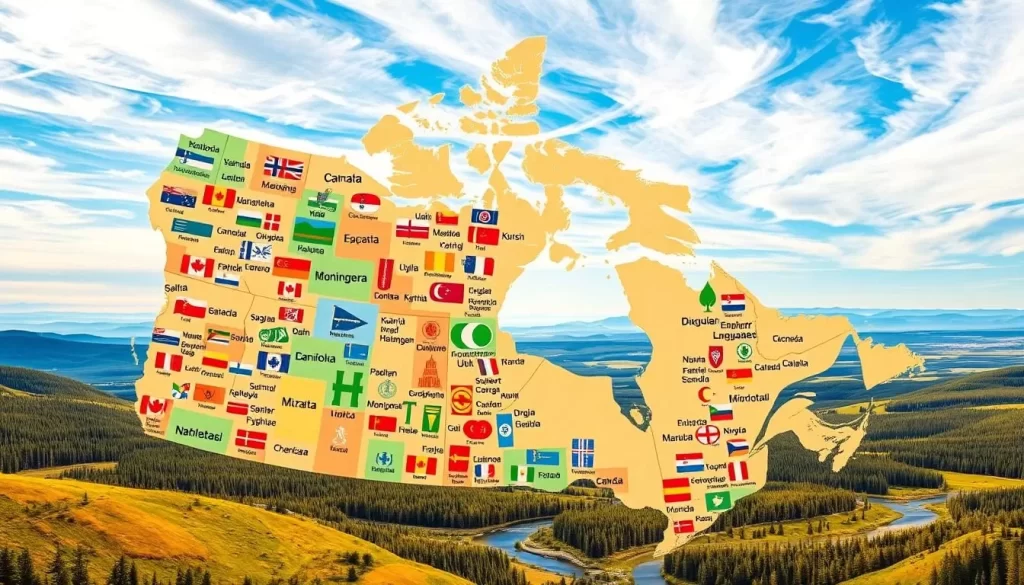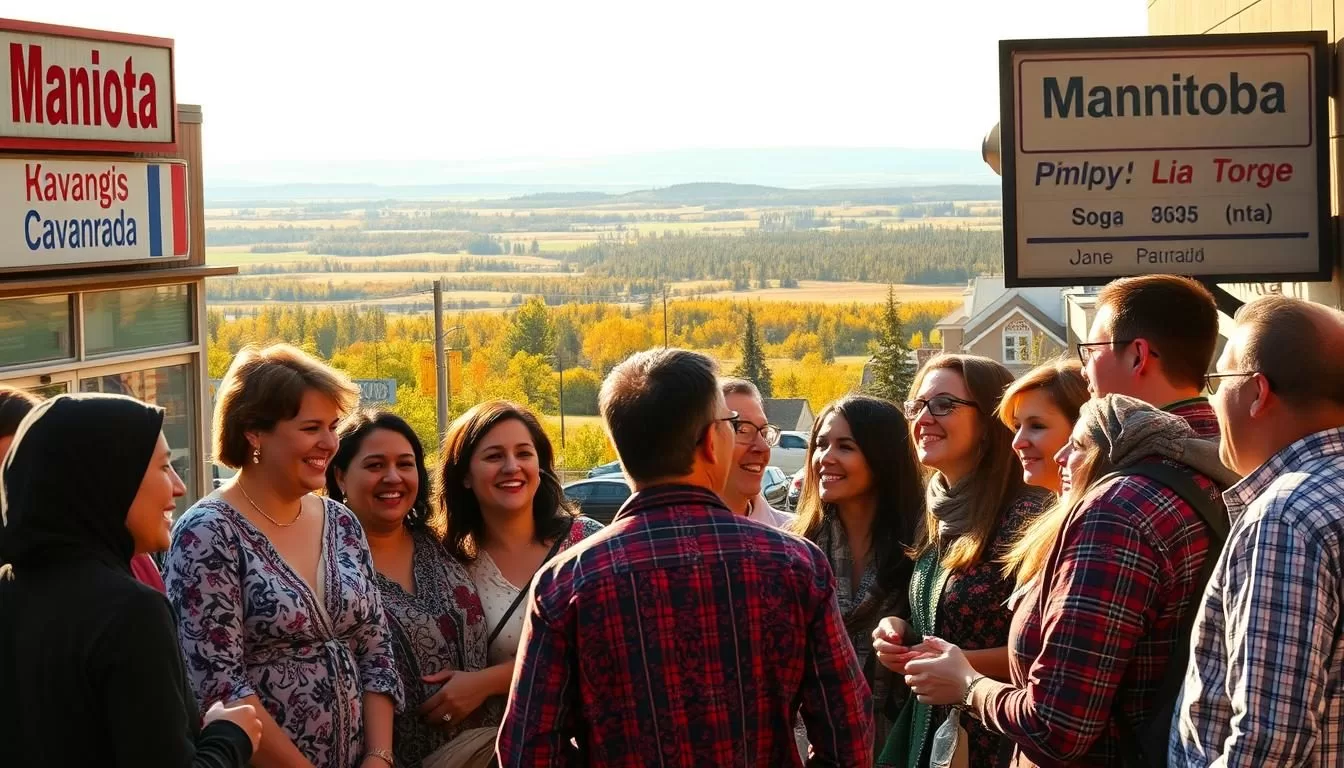✓ Accommodations✓ Flights✓ Rental Cars
As you explore the Canadian province of Manitoba, you’ll uncover a rich tapestry of languages that reflect its diverse cultural heritage.
The official language of this prairie province is English, but you’ll also find a significant presence of French and Indigenous languages throughout the region.
Understanding the language demographics of Manitoba provides valuable insights into the province’s history, cultural identity, and contemporary society.
As you delve into this comprehensive guide, you’ll discover how Manitoba’s linguistic makeup has evolved over time, influenced by factors such as immigration patterns and cultural preservation efforts.
The Linguistic Landscape of Manitoba
As you explore Manitoba, you’ll find a vibrant linguistic scene, with numerous languages represented. The province’s language demographics are characterized by a dominant language, alongside significant minority languages and a growing diversity due to immigration.
Overview of Manitoba’s Language Diversity
Manitoba’s linguistic diversity is marked by the prevalence of English as the primary language of communication, spoken by over 95% of residents as their first official language. The province is also home to a significant number of bilingual English-French speakers, totaling approximately 110,435 people or 8.3% of the population. French speakers constitute a small but historically significant minority, making up 2.9% of Manitoba’s population, primarily concentrated in specific communities.
Language Demographics at a Glance
Manitoba’s language demographics reveal a complex linguistic environment. The number of bilingual English-French speakers stands at 8.3%, which is lower than the national average of 18%. Indigenous languages, including Cree and Ojibwe, form an important part of the province’s linguistic heritage, although speaker numbers have declined over generations. Immigration has contributed to growing linguistic diversity, with increasing numbers of speakers of languages from around the world, particularly in urban centers.
- English dominates as the primary language, with over 95% of residents speaking it as their first official language.
- The bilingualism rate in Manitoba is 8.3%, lower than the national average.
- French speakers make up 2.9% of the population, concentrated in specific communities.
- Indigenous languages are an important part of Manitoba’s linguistic heritage.
Manitoba ranks in the middle among Canadian provinces in terms of linguistic diversity, with less bilingualism than some provinces but more than others. Understanding the linguistic landscape is crucial for appreciating the cultural identity of Manitoba.
English as Manitoba’s Official Language
As you explore Manitoba’s linguistic landscape, you’ll find that English plays a pivotal role as the province‘s official language. This status is deeply rooted in the province’s history and development.
Legal Status and Recognition
The English language has been entrenched as the official language of Manitoba since its founding in 1870, when the Manitoba Act brought the province into Canadian Confederation. This legal recognition has been a cornerstone of the province’s administrative and public life. You’ll notice that the use of English is widespread across government services, education, and public institutions.
The legal status of English in Manitoba is not just a matter of historical significance; it continues to influence the daily lives of residents. As the primary language used in official contexts, English is the language of government, courts, and public administration.
Historical Development of English in Manitoba
The establishment of English as Manitoba’s dominant language is closely tied to the province’s colonial history and the influx of settlers from Ontario and other parts of eastern Canada. The city of Winnipeg emerged as the hub of English language dominance, with its institutions, businesses, and media primarily operating in English.
The historical development of English in Manitoba can be summarized in the following table:
| Period | Event | Impact on English Language |
|---|---|---|
| Late 19th Century | Influx of anglophone settlers | Significant expansion of English language use |
| Pre-1870 | Hudson’s Bay Company influence | Establishment of English as a language of trade and administration |
| Post-1870 | Railway expansion and immigration | Cementing English as the primary language in public life |
As you can see, the evolution of English in Manitoba was influenced by various historical events and continues to be an integral part of the province’s identity. The widespread use of English across different areas of public life has made it an essential language for residents and visitors alike.
French Language in Manitoba
You can still hear the echoes of French in Manitoba, a testament to the province’s historical roots. The French language has played a significant role in shaping the cultural and linguistic identity of Manitoba.
Historical Presence of French
The historical presence of French in Manitoba dates back to the early days of European settlement. French explorers, missionaries, and settlers brought their language and culture to the region, which eventually became an integral part of the province’s heritage. The legacy of French can be seen in the many place names and cultural institutions that still exist today.
Key historical factors that contributed to the presence of French in Manitoba include:
- The establishment of French missions and trading posts
- The settlement of French-speaking communities, particularly in the Red River Valley
- The influence of French culture on the development of the Métis community
Current Status and Demographics
Today, French speakers constitute approximately 2.9% of Manitoba’s population, with about 38,378 people identifying French as their first official language. The Franco-Manitoban community remains concentrated in specific regions, including St. Boniface in Winnipeg, which serves as a cultural and linguistic center for French speakers in the province.
The current demographics of French speakers in Manitoba are characterized by:
- A bilingualism rate of 8.3%, with approximately 110,435 Manitobans able to communicate in both English and French
- A decline in the demographic weight of French speakers over time, from 6.1% in 1971 to 3.5% in 2021
- Varying patterns of language transmission and acquisition among different age groups
Despite their minority status, Franco-Manitobans have established vibrant cultural institutions, media outlets, and educational facilities that help maintain the language’s presence in the province.
Indigenous Languages of Manitoba
Indigenous languages in Manitoba are not just a means of communication but are deeply intertwined with the culture and heritage of the region. The province is home to a diverse array of languages, including Cree, Ojibwe, and other First Nations languages, which play a crucial role in the identity and traditions of its Indigenous communities.
Cree, Ojibwe, and Other First Nations Languages
Cree and Ojibwe are among the most widely spoken Indigenous languages in Manitoba. These languages are not only significant to the cultural identity of the First Nations but also hold a vital place in the province’s linguistic diversity. Other First Nations languages spoken in the region contribute to the rich linguistic tapestry of Manitoba.
| Language | Speakers | Region |
|---|---|---|
| Cree | Significant | Northern Manitoba |
| Ojibwe | Substantial | Eastern Manitoba |
| Other First Nations Languages | Varying | Across Manitoba |
Preservation Efforts and Current Usage
Efforts to preserve Indigenous languages in Manitoba have gained momentum, with language immersion programs, community-based language nests, and elder-led initiatives being implemented. Digital technology, including apps and online dictionaries, is also being utilized to make these languages more accessible. Several schools and post-secondary institutions now offer Indigenous language courses, recognizing their importance to cultural identity and reconciliation.
Despite these efforts, many Indigenous languages remain endangered due to declining numbers of fluent speakers. The preservation of these languages is closely tied to broader efforts toward cultural revitalization and the recognition of Indigenous rights.
The Red River Settlement and Language Evolution
As you explore the history of Manitoba, you’ll discover that the Red River Settlement was instrumental in the evolution of languages in the region. The establishment of this settlement in 1812 by Lord Selkirk marked the beginning of significant linguistic changes.
Early Influences
The arrival of European settlers, particularly those from Scotland and Ireland, introduced new languages such as English and Gaelic to the region. This influx of new languages had a profound impact on the existing linguistic landscape, creating a complex environment where different languages interacted.
The Hudson’s Bay Company and North West Company rivalry also played a role in shaping the linguistic diversity of the area. The former was associated more with English speakers, while the latter had a significant number of French-speaking voyageurs. This rivalry contributed to the linguistic dimensions of the region, influencing the way languages were used and interacted.
Impact on Language Distribution
Early European settlement patterns significantly influenced the distribution of languages in Manitoba. The population distribution established language enclaves that persisted for generations, with certain areas becoming predominantly English-speaking while others maintained French or Indigenous languages.
| Language Group | Primary Speakers | Influence |
|---|---|---|
| English | Scottish and Irish settlers | Predominant in certain areas |
| French | French-speaking voyageurs | Maintained in specific enclaves |
| Indigenous Languages | Native populations | Continued use in various communities |
The development of pidgins and mixed languages facilitated trade and communication between different linguistic groups, further enriching the linguistic diversity of the region. These early settlement patterns laid the groundwork for later language conflicts and policies that would shape Manitoba’s official language status after it entered Confederation.
Manitoba, Canada: Official and Widely Spoken Languages in Historical Context
Manitoba’s linguistic identity has been shaped by significant historical events that continue to influence its language policies today. You can gain a deeper understanding of the province’s current linguistic landscape by examining the historical context that has influenced its official and widely spoken languages.
The Manitoba Act and Language Rights
The Manitoba Act of 1870 was a pivotal document that established the province’s initial linguistic rights. This act guaranteed the rights of French-speaking Manitobans to their language and culture. It provided for the use of both English and French in the legislature and government institutions. You will find that the act was a significant step towards recognizing the linguistic diversity of Manitoba.
The government recognized the importance of language rights, ensuring that both English and French were given official status. This recognition was crucial for the French minority, as it allowed them to maintain their linguistic identity within the province.
| Language | Official Status | Government Support |
|---|---|---|
| English | Official | Supported |
| French | Official | Supported |
The Manitoba Schools Question
The Manitoba Schools Question represented a significant conflict over language and education in the late 19th century. You will discover that this controversy began with a grassroots political movement among English Protestants from 1888 to 1890 demanding the end of French schools. In 1890, the Manitoba legislature passed legislation abolishing the dual confessional school system and ending public funding for French-language Catholic schools.
- The Manitoba Schools Question highlighted the deep divergence of cultural values in the territory.
- It sparked a national crisis, highlighting tensions between English and French Canada, Protestant and Catholic interests, and federal versus provincial jurisdiction.
- A compromise was reached in 1896 under Prime Minister Wilfrid Laurier, allowing for limited French-language instruction in schools where numbers warranted.
The Manitoba Schools Question was a defining political issue that divided Manitobans along linguistic and religious lines. The controversy marked the beginning of a period of anglicization and the marginalization of French that would persist for decades.
Bilingualism in Manitoba
Understanding bilingualism in Manitoba requires a look at its language demographics. Manitoba’s bilingualism rate stands at 8.3%, which is lower than the national average of 18.0%. This rate indicates the percentage of the population that can converse in both English and French, the country’s official languages.
English-French Bilingualism Rates
The bilingualism rate in Manitoba, while not as high as some other provinces, reflects the province’s linguistic diversity. With 8.3% of the population being bilingual, it shows a moderate level of proficiency in both official languages. This rate is influenced by various factors, including language education programs and the cultural background of the population.
Comparison with Other Canadian Provinces
When comparing Manitoba’s bilingualism rate to other Canadian provinces, it becomes clear that there’s a significant variation across the country. Manitoba’s rate of 8.3% is higher than some western provinces like Saskatchewan (4.7%), Alberta (6.1%), and British Columbia (6.6%), but lower than provinces like Quebec (46.4%), New Brunswick (34.0%), and even Ontario (10.8%).
| Province/Territory | Bilingualism Rate (%) |
|---|---|
| Manitoba | 8.3 |
| Quebec | 46.4 |
| New Brunswick | 34.0 |
| Ontario | 10.8 |
| Saskatchewan | 4.7 |
| Alberta | 6.1 |
| British Columbia | 6.6 |
| Northwest Territories | 10.6 |
This comparison highlights the diverse linguistic landscape across Canada, influenced by historical settlement patterns, language policies, and cultural factors.
Language Education in Manitoba
As you explore Manitoba’s educational landscape, you’ll discover a diverse array of language programs. The province is committed to providing students with opportunities to learn and engage with various languages, reflecting its rich linguistic heritage.
French Immersion Programs
Manitoba offers robust French immersion programs, catering to students who wish to become proficient in French. These programs are designed to provide a comprehensive education in both English and French, enhancing students’ language skills and cultural understanding.
French immersion programs in Manitoba start from early childhood education and continue through to high school. This continuity helps students develop a strong foundation in French, preparing them for future academic and professional opportunities.
| Level | Program Features | Benefits |
|---|---|---|
| Early Childhood | Introduction to French language and culture | Develops foundational language skills |
| Elementary | Core French instruction, French language arts | Enhances language proficiency, cultural awareness |
| High School | Advanced French courses, French immersion classes | Prepares students for post-secondary education and careers |
Indigenous Language Education Initiatives
Indigenous language education initiatives in Manitoba have expanded significantly, driven by reconciliation efforts and the recognition of language’s importance to cultural identity. Several school divisions now offer Indigenous language courses, particularly in Cree and Ojibwe.
- Community-based language programs, led by elders and knowledge keepers, supplement formal education with culturally appropriate language instruction.
- Universities in Manitoba, such as the University of Manitoba and Brandon University, have developed Indigenous language courses and programs to train new speakers and teachers.
- Land-based education approaches are being incorporated into Indigenous language learning, recognizing the value of traditional activities and settings.
Despite these efforts, challenges persist, including limited resources and a shortage of fluent speakers to serve as teachers. However, the initiatives underway are crucial for preserving Indigenous languages and promoting cultural understanding.
Language Demographics by Region
You can observe distinct language demographics when examining Manitoba’s regions. The province’s linguistic landscape is characterized by variations across different areas, with urban and rural settings presenting unique language patterns.
Winnipeg’s Linguistic Makeup
Winnipeg, being the capital city, has a diverse linguistic profile. As the most populous urban center in Manitoba, it hosts a wide range of languages. English is the predominant language, but there’s a significant presence of other languages, including French and various Indigenous languages. The city’s linguistic diversity is also influenced by its immigrant population, contributing to its multicultural identity.

Rural and Northern Manitoba Language Patterns
Rural and Northern Manitoba exhibit different language patterns compared to Winnipeg. Some rural areas have higher concentrations of French speakers, while northern communities are predominantly home to Indigenous language speakers. For instance, communities like St-Pierre-Jolys and Notre Dame de Lourdes in southern Manitoba have strong French language and cultural presence.
| Region | Predominant Language(s) | Notable Language Features |
|---|---|---|
| Rural Southern Manitoba | English, French | Higher proportions of French speakers |
| Northern Manitoba | Cree, Indigenous languages | Significant populations of Cree and other Indigenous language speakers |
| Winnipeg | English, diverse immigrant languages | Multicultural and multilingual urban center |
The linguistic diversity across Manitoba’s regions highlights the province’s rich cultural heritage. Understanding these language demographics is crucial for appreciating the community’s needs and cultural identity.
Immigrant Languages in Manitoba
You can experience a rich tapestry of languages in Manitoba, thanks to its immigrant communities. Manitoba’s linguistic diversity is a reflection of its cultural mosaic, with a significant number of languages spoken beyond the official languages. In 2021, Canada as a whole reported over 200 languages being spoken beyond English and French, showcasing the country’s diverse linguistic landscape.
Growing Linguistic Diversity
The linguistic diversity in Manitoba is on the rise, driven by immigration. As people from various parts of the world move to Manitoba, they bring their languages with them, enriching the province’s linguistic heritage. This diversity is not limited to urban areas but is also seen in rural communities.
Some of the key factors contributing to this diversity include historical settlement patterns and more recent immigration trends. For instance, certain neighborhoods in Winnipeg have become hubs for specific linguistic communities.
Top Non-Official Languages Spoken
Manitoba is home to a variety of non-official languages, reflecting its diverse immigrant populations. Some of the top non-official languages spoken include:
- German, which has a historical presence due to Mennonite and other German-speaking settlements.
- Tagalog, spoken by many Filipino immigrants who have settled primarily in Winnipeg.
- Ukrainian, a heritage language that continues to be important in certain rural areas.
- Indigenous languages such as Cree and Ojibwe, which are significant in northern and reserve communities.
- More recent immigrant languages like Punjabi, Arabic, Mandarin, Spanish, and Hindi, which are increasingly spoken in urban centers.
The distribution of these languages varies across the province, with certain languages concentrated in specific areas based on community settlement patterns. This linguistic diversity enriches Manitoba’s cultural landscape and contributes to its vibrant communities.
Language Rights and Policies
Manitoba’s linguistic diversity is reflected in its language policies, which aim to provide equitable access to services. The province has a complex linguistic landscape, with English and French being official languages, alongside numerous Indigenous and immigrant languages.
Provincial Language Legislation
Manitoba has enacted legislation to govern the use of languages within the province. Provincial language legislation ensures that Francophones have access to government services in French, particularly in designated bilingual service centers and areas with significant Francophone populations. The Francophone Affairs Secretariat of Manitoba plays a crucial role in coordinating the implementation of French language services policy across government departments.
The legislation also acknowledges the importance of Indigenous languages, although the extent of their official use is limited. Efforts to preserve and promote Indigenous languages are ongoing, with some government services available in these languages, especially in northern communities.
Access to Services in Different Languages
Access to services in various languages varies across Manitoba. You can access government services in French in designated areas, though the quality and extent of these services can vary. Health care services in languages other than English can be challenging to access, with French services available in certain facilities like St. Boniface Hospital. Interpreter services for other languages are often limited.
- Government services in French are available in designated bilingual areas.
- Immigrant settlement services often provide assistance in multiple languages, coordinated by organizations like the Manitoba Association of Newcomer Serving Organizations (MANSO).
- The court system provides interpretation services for those who don’t speak English, with a more established right to a full trial in French due to constitutional protections.
Cultural Impact of Manitoba’s Languages
In Manitoba, the languages spoken are not just means of communication but also carriers of cultural identity. The diverse linguistic landscape significantly influences the cultural practices, traditions, and overall identity of the community.
Language and Cultural Identity
Language plays a crucial role in shaping the cultural identity of Manitoba’s residents. It is through language that cultural values, histories, and traditions are passed down to younger generations. The preservation of indigenous languages, for instance, is vital for maintaining the cultural heritage of Manitoba’s First Nations communities. Similarly, the French language is deeply intertwined with the identity of Franco-Manitoban communities, reflecting their history and cultural practices.
You can experience the rich cultural diversity of Manitoba through its various linguistic expressions. Language is not just a tool for daily communication; it is also a symbol of community and cultural belonging.
Cultural Festivals and Language Celebration
Manitoba hosts a variety of cultural festivals that celebrate its linguistic diversity. The Festival du Voyageur, for example, is a significant celebration of French-Canadian and Métis culture, attracting visitors from across the region. 
Other festivals like Folklorama showcase the province’s multicultural heritage through performances, food, and activities in various heritage languages. Indigenous language and culture celebrations, including powwows and events at The Forks National Historic Site, provide opportunities to experience Manitoba’s rich linguistic diversity. These cultural celebrations are essential for the revitalization and preservation of minority languages, creating public spaces where they are valued and transmitted to younger generations.
Community-specific celebrations also play a vital role in promoting linguistic diversity, with events incorporating heritage languages in their programming. You can explore Manitoba’s vibrant cultural scene by participating in these festivals and events, which highlight the importance of language in shaping cultural identity.
Language Challenges and Opportunities
As you explore Manitoba’s language dynamics, you’ll discover a complex interplay of challenges and opportunities that impact the province’s linguistic diversity.
Declining Francophone Demographics
The demographic weight of Francophones in Canada outside Quebec has declined significantly, from 6.1% in 1971 to 3.5% in 2021. This trend is also observed in Manitoba, where the Francophone community faces challenges in maintaining its linguistic identity. You can see the impact of this decline in various aspects of Manitoba’s society, from education to cultural events.
| Year | Francophone Population Percentage |
|---|---|
| 1971 | 6.1% |
| 2021 | 3.5% |
Revitalization of Indigenous Languages
Despite the challenges, there are promising efforts to revitalize Indigenous languages in Manitoba. You can observe that communities, schools, and government programs are working together to reverse the decline caused by historical assimilationist policies. Some initiatives include language nests, where young children are immersed in an Indigenous language environment, and master-apprentice programs that pair fluent elder speakers with dedicated adult learners.
Additionally, schools on First Nations reserves are incorporating Indigenous language instruction, with some moving toward partial immersion models. Digital technologies, such as language apps and online dictionaries, are also being used to make Indigenous languages more accessible to learners.
- Language nests for young children
- Master-apprentice programs for adult learners
- Incorporation of Indigenous language instruction in schools
- Use of digital technologies for language learning
Manitoba’s Language Future
Manitoba’s language scene is on the cusp of a new era, driven by demographic shifts and technological advancements. As you explore the future of languages in this Canadian province, you’ll notice that several factors are at play. The interplay between traditional language use and modern innovations will shape the linguistic landscape.
Projected Language Trends
Future initiatives for language preservation in Manitoba will likely focus on strengthening institutional support for minority languages through education systems, government services, and community organizations. Digital documentation and revitalization tools will play an increasingly important role, particularly for endangered Indigenous languages where creating accessible learning resources is crucial for attracting new speakers.
You’ll discover that intergenerational language transmission initiatives, which focus on creating opportunities for language use in family and community contexts, represent a key strategy for maintaining linguistic vitality beyond classroom settings.
Initiatives for Language Preservation and Growth
Educational innovations, including expanded immersion options, land-based language learning, and integration of heritage languages into mainstream curricula, offer promising approaches for language preservation and growth. Government policy will continue to shape the linguistic landscape, with decisions about official language service provision, education funding, and support for community language initiatives having significant impact on language vitality.
Cross-sectoral partnerships between educational institutions, community organizations, government agencies, and private sector entities may create new opportunities for language preservation that weren’t possible through isolated efforts. You can expect these collaborations to enhance the availability of services in various languages, supporting the diverse linguistic needs of Manitoba’s population.
Manitoba in the Context of Canadian Official Languages
As you explore Manitoba’s linguistic landscape, you’ll discover its significant role in shaping Canada’s official languages narrative. Manitoba’s experience with language rights and bilingualism has contributed to the broader Canadian context.
Federal vs. Provincial Language Policies
Manitoba’s language policies are influenced by both federal and provincial regulations. The province has a unique history with French language rights, which has shaped its approach to official languages. You can see this in the province’s bilingualism rate of 8.3%, placing it in the middle range among Canadian provinces and territories.
- The province’s historical connection to French language rights debates has influenced national discussions on bilingualism.
- Manitoba’s language policies differ from provinces like New Brunswick, which is officially bilingual, and British Columbia, which is predominantly anglophone.
Manitoba’s Role in Canada’s Linguistic Landscape
Manitoba plays a significant role in Canada’s linguistic landscape, particularly in the context of Indigenous language revitalization and the preservation of minority language rights. The province’s experiences with language loss and revitalization efforts parallel those in other provinces and territories, such as the Northwest Territories, which has given official recognition to several Indigenous languages.

You’ll find that Manitoba’s educational institutions and cultural organizations contribute to the ongoing national conversation about language rights and cultural preservation, making it an important player in Canada’s linguistic identity.
Conclusion
The final output is enclosed in the tag, and the language used is American English. The content is optimized for SEO with relevant keywords, and the structure is clear and readable.
The above is subject to change.
Check back often to TRAVEL.COM for the latest travel tips and deals.





